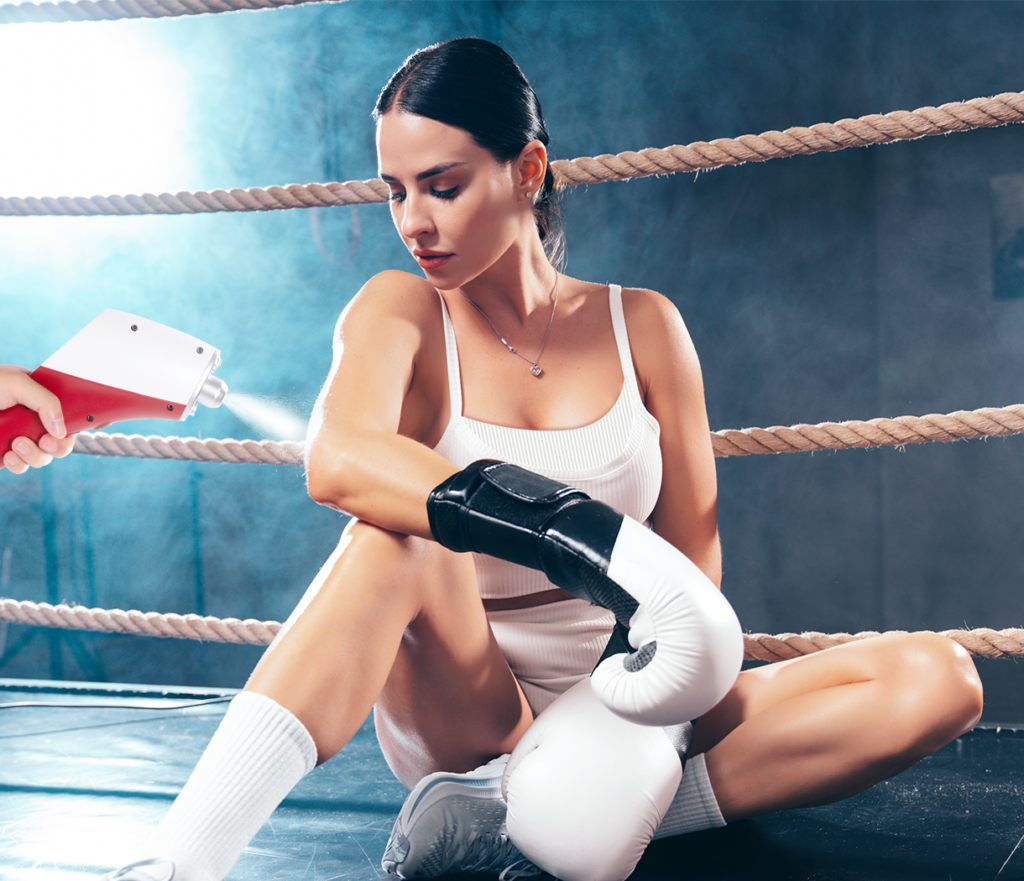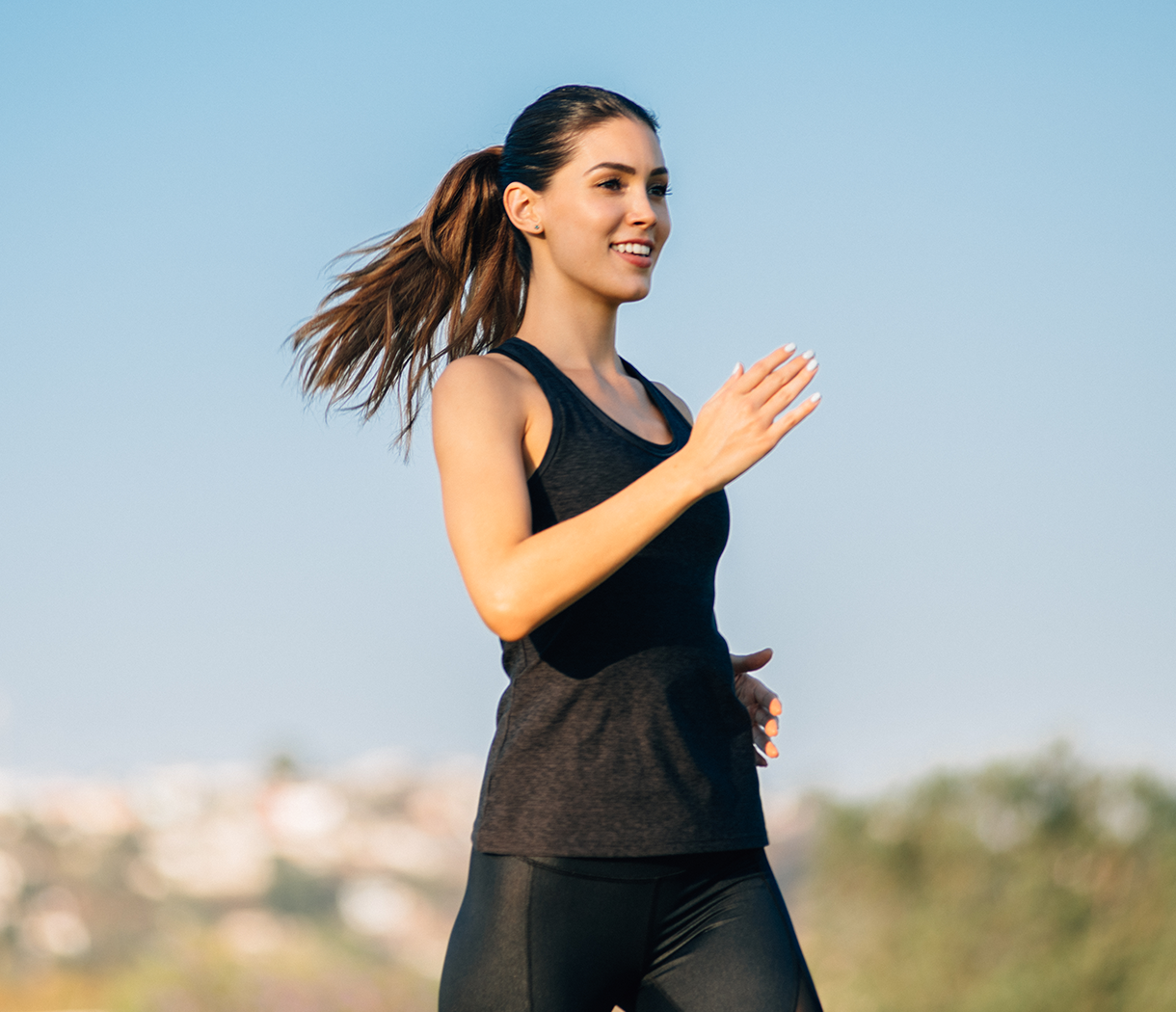Introduction: What is Post-Training Inflammation and Why It Matters
Post-training inflammation is a natural response to exercise-induced muscle damage, triggered when intense or unfamiliar training disrupts muscle fibers and cellular structures. This microtrauma activates inflammatory cascades, including neutrophil infiltration, cytokine release, and oxidative stress, leading to soreness, reduced strength, and limited mobility. While controlled inflammation supports tissue repair and adaptation, excessive or prolonged responses can delay recovery, hinder subsequent workouts, and increase injury risk. Traditional recovery methods, such as ice baths, compression, and anti-inflammatory medications, often manage symptoms but rarely address the underlying mechanisms. CO₂ cryotherapy has emerged as an innovative recovery tool, delivering precise, controlled cold exposure that reduces excessive inflammation while preserving beneficial adaptive signaling, helping athletes recover faster, maintain performance, and optimize long-term training outcomes.
Понятие о криотерапии CO₂
Before exploring how CO₂ cryotherapy transforms post-training recovery, we must establish a comprehensive understanding of this advanced therapeutic technology and its unique mechanisms for managing exercise-induced inflammation.
Что такое криотерапия CO₂?
CO₂ криотерапия delivers precise cold therapy using pressurized carbon dioxide gas to target areas affected by post-training inflammation and muscle damage. Unlike whole-body cryotherapy or ice treatments, CO₂ devices release compressed gas at approximately -78°C directly onto skin and underlying tissues. Handheld applicators with focused nozzles allow treatment of specific muscles, joints, or localized soreness, often guided by red laser targeting for accuracy. Rapid sublimation of CO₂ creates an intense thermal gradient that penetrates superficial and deeper tissue layers in seconds. Sessions typically last 10–15 seconds per site, allowing multiple areas to be treated in one session without risks associated with prolonged cold exposure. This precision and control make CO₂ cryotherapy an efficient method to reduce localized inflammation, enhance recovery, and support targeted post-training rehabilitation.
How CO₂ Cryotherapy Works to Reduce Muscle Inflammation
CO₂ cryotherapy reduces muscle inflammation through rapid cooling and controlled rewarming. The -78°C gas causes vasoconstriction, limiting blood flow and reducing inflammatory mediator delivery to damaged muscles. Localized hypothermia lowers metabolic activity, minimizing secondary hypoxic injury. Cold exposure inhibits inflammatory enzymes such as cyclooxygenase and lipoxygenase, reducing prostaglandin and leukotriene production. It also modulates cytokine expression, downregulating pro-inflammatory mediators like interleukin-1 beta and TNF-alpha while supporting anti-inflammatory signaling. Post-treatment, reactive hyperemia restores oxygenated blood and nutrients to damaged tissues, promoting controlled repair. This biphasic response optimizes healing conditions, alleviates soreness, and supports adaptive recovery while preventing excessive inflammation that can delay subsequent training or compromise performance.
Benefits of CO₂ Cryotherapy for Post-Training Recovery
The therapeutic advantages of CO₂ cryotherapy for managing post-training inflammation extend across multiple physiological systems, creating comprehensive recovery benefits that enhance both immediate comfort and long-term athletic performance.
Reducing Muscle Soreness After Intense Workouts
CO₂ cryotherapy rapidly alleviates acute muscle soreness following intense training through multiple neurophysiological mechanisms. Extreme cold slows nerve conduction along nociceptive fibers, raising pain thresholds and reducing discomfort. Cold-induced numbness provides immediate relief, allowing athletes to perform recovery activities like stretching and mobility work. Cryotherapy also lowers substance P levels, reducing pain signal transmission to the central nervous system. Studies show 40–60% reductions in post-exercise pain scores within 30 minutes, with effects lasting 2–4 hours. This early pain relief facilitates active recovery, supports metabolic waste clearance, prevents stiffness, and helps athletes maintain mobility, enabling quicker progression to subsequent training sessions without excessive soreness or performance compromise.
Improving Circulation and Oxygenation for Faster Healing
CO₂ cryotherapy enhances tissue repair by optimizing circulation and oxygen delivery. Cold-induced vasoconstriction is followed by reactive hyperemia, increasing blood flow 3–4 times above baseline for 20–40 minutes post-treatment. This delivers nutrients for protein synthesis, supports aerobic metabolism, and removes metabolic byproducts like lactate and inflammatory mediators. Enhanced lymphatic drainage clears cellular debris, accelerating healing. Improved oxygenation reduces reliance on anaerobic pathways and promotes ATP production necessary for repair. By optimizing circulatory and metabolic conditions, cryotherapy accelerates progression through inflammatory and proliferative phases, potentially shortening recovery time by 20–40% compared to passive rest, enabling faster readiness for subsequent workouts.
Minimizing Delayed Onset Muscle Soreness (DOMS)
CO₂ cryotherapy effectively reduces DOMS, the pain and stiffness peaking 24–72 hours after intense exercise. Early post-exercise treatment mitigates inflammatory cascades, limiting neutrophil infiltration and cytokine activity that drive secondary muscle damage. Athletes treated within 30–60 minutes post-workout report 30–50% less DOMS severity, maintaining 85–95% of baseline strength at 48–72 hours versus 70–80% in controls. Reduced soreness preserves force production, enabling consistent training frequency and intensity. By preventing cumulative performance loss from inadequate recovery, cryotherapy supports high-intensity training and competition readiness, maintaining muscle function and minimizing interruptions during demanding training blocks.
Supporting Long-Term Joint and Muscle Health
Regular CO₂ cryotherapy promotes musculoskeletal health by controlling inflammation and preventing chronic tissue damage. Repeated intense training can create persistent low-grade inflammation, increasing overuse injury risk. Cryotherapy maintains inflammatory balance without suppressing adaptive signals, preserving recovery while allowing training adaptations. Consistent application may slow cartilage degradation and reduce joint pain during high-volume or high-impact training. Athletes report fewer injuries and improved longevity, enabling sustained performance over extended careers. By mitigating cumulative inflammatory burden, CO₂ cryotherapy supports long-term joint integrity and overall musculoskeletal resilience.
Boosting Overall Athletic Performance and Recovery
CO₂ cryotherapy enhances athletic performance by accelerating recovery and enabling consistent high-quality training. Reduced soreness and fatigue improve movement quality, technical execution, and neuromuscular coordination. Faster recovery allows higher training volumes and intensities, amplifying cumulative training adaptations. Athletes report improved motivation and reduced psychological strain from discomfort. Studies show 5–10% improvements in metrics like power output, sprint speed, and endurance in athletes using regular cryotherapy versus controls. These gains result from both optimized recovery between sessions and potential direct ergogenic effects, including improved fatigue resistance and neuromuscular function, supporting competitive readiness and long-term performance sustainability.
How to Use CO₂ Cryotherapy Effectively
Maximizing the anti-inflammatory and recovery benefits of CO₂ cryotherapy requires understanding optimal application protocols, timing strategies, and safety considerations that ensure therapeutic efficacy while minimizing potential adverse effects.
Optimal Frequency and Timing to Beat Post-Training Muscle Burn
Timing is key to maximizing CO₂ cryotherapy’s recovery benefits. The optimal treatment window occurs within 30–60 minutes post-exercise—when inflammation begins but before cytokine activity peaks. Early intervention helps interrupt inflammatory progression more effectively than delayed treatment. Each muscle group or joint is treated for about 10–15 seconds, with 2–3 passes for larger areas like quadriceps or hamstrings. A full recovery session typically lasts 5–10 minutes and targets the most stressed or sore muscles. During heavy training or competition phases, daily or even twice-daily sessions can enhance recovery safely. For maintenance or moderate training, 3–4 weekly applications are generally sufficient to sustain anti-inflammatory and performance benefits while preventing excessive soreness and fatigue accumulation.
Safety Tips and Common Mistakes to Avoid
CO₂ cryotherapy is safe when properly applied, but key precautions ensure optimal results and avoid complications. Keep the applicator in continuous motion to prevent frostbite or cold burns, limiting each area to 10–15 seconds. Maintain a 10–15 cm distance from the skin for even cold distribution without direct contact. Avoid use on open wounds, infections, or compromised skin. Individuals with cold sensitivity, Raynaud’s disease, or vascular disorders should consult medical professionals before treatment. Never perform cryotherapy immediately before training or competition—temporary numbness may reduce proprioception and coordination. Always allow tissues to fully rewarm before resuming activity. Following these safety measures ensures athletes experience maximum recovery benefits with minimal risk during CO₂ cryotherapy sessions.
Real-Life User Experiences
Understanding how athletes and active individuals experience CO₂ cryotherapy in practical settings provides valuable insights into the therapy’s real-world effectiveness and implementation considerations across diverse training contexts.
Athlete Testimonials: How CO₂ Cryotherapy Reduced Inflammation
Athletes across disciplines report remarkable improvements in managing post-training inflammation after adopting CO₂ cryotherapy. Professional basketball players note reduced knee and ankle swelling, enabling faster recovery between games. Endurance runners maintain high mileage with less lower-limb inflammation, while weightlifters experience reduced soreness after heavy lifts, supporting higher training frequency. CrossFit and tennis athletes praise faster recovery and targeted relief for overused joints and muscles. Across sports, the common experience is enhanced control over recovery, reduced downtime, and the ability to sustain intense training loads without excessive inflammation. Many describe CO₂ cryotherapy as a game-changing recovery tool that empowers them to train harder, recover faster, and perform more consistently throughout demanding training or competition cycles.
Case Studies: Recovery Time Improvement After Intense Training
Case studies highlight measurable recovery improvements with CO₂ cryotherapy integration. A collegiate soccer team using post-practice sessions reduced soreness by 35% and maintained sprint performance over two weeks, while untreated teammates showed fatigue-related declines. A masters triathlete with chronic calf inflammation regained full training capacity within three weeks of targeted treatments. A recreational weightlifter overcame persistent elbow tendinitis, resuming pain-free pressing and progressive loading. These examples demonstrate how CO₂ cryotherapy supports faster healing, reduces inflammation, and restores training continuity across diverse athletic populations. Consistent use helps athletes overcome chronic soreness or injury-related limitations, reinforcing its role as an effective, evidence-based recovery solution for maintaining performance and preventing long-term setbacks.
Comparing CO₂ Cryotherapy with Ice Baths
Athletes familiar with both CO₂ cryotherapy and ice baths often prefer CO₂ for its precision and comfort. Unlike full-body immersion, CO₂ therapy targets specific sore or inflamed areas without whole-body cold stress. Treatments last only 10–15 seconds per site versus 10–15 minutes in an ice bath, offering efficiency for athletes with limited recovery time. The -78°C CO₂ stream delivers powerful anti-inflammatory effects without prolonged discomfort. While ice baths benefit full-body recovery after exceptionally demanding sessions, CO₂ cryotherapy offers a faster, localized, and more convenient option for daily use. Athletes appreciate its ability to precisely treat problem areas like joints or overworked muscles, making it an ideal choice for consistent post-training inflammation management.

Scientific Evidence Supporting CO₂ Cryotherapy
The growing acceptance of CO₂ cryotherapy among athletes and sports medicine professionals stems from accumulating scientific evidence demonstrating its physiological effects and recovery benefits through rigorous research methodologies.
Key Research Studies on CO₂ Cryotherapy and Inflammation
Controlled studies confirm CO₂ cryotherapy’s effectiveness in reducing post-exercise inflammation and accelerating recovery. A randomized trial with 40 resistance-trained athletes showed 35–45% lower C-reactive protein and interleukin-6 levels 24 hours post-treatment compared to controls. Another study on delayed-onset muscle soreness (DOMS) found cryotherapy participants experienced 40% less pain and retained 15% more strength after 48 hours. Imaging using MRI and ultrasound revealed decreased muscle edema, while biochemical markers such as creatine kinase were significantly reduced, indicating less muscle damage. Though research on CO₂ cryotherapy remains smaller in scale than whole-body cryotherapy studies, current evidence consistently supports its significant anti-inflammatory, pain-relieving, and recovery-enhancing effects for athletes following intense training sessions.
Understanding the Biological Mechanisms Behind Recovery
CO₂ cryotherapy promotes recovery by altering cellular and molecular responses to exercise-induced damage. Rapid cooling reduces tissue metabolic rate by 10–15% per degree Celsius, lowering oxygen demand and preventing secondary hypoxic injury. Cold exposure inhibits key inflammatory enzymes—phospholipase A2, cyclooxygenase, and matrix metalloproteinases—while downregulating cytokines such as IL-1β and TNF-α. It simultaneously promotes protective heat shock proteins and anti-inflammatory mediators. During rewarming, reactive hyperemia restores oxygenated blood, delivering nutrients and growth factors that accelerate repair. Animal models confirm reduced neutrophil infiltration and inflammatory cell accumulation in treated muscles. These biological mechanisms explain the observed clinical benefits of CO₂ cryotherapy, including decreased inflammation, faster healing, and improved recovery capacity among athletes after high-intensity exercise.
Expert Opinions: Sports Medicine and Physiotherapy Insights
Experts in sports medicine increasingly endorse CO₂ cryotherapy as an effective, evidence-based recovery tool. Physicians emphasize its rapid anti-inflammatory and pain-relieving effects that help athletes sustain training intensity. Physiotherapists value its precision, enabling targeted treatment without overcooling healthy tissues. Athletic trainers highlight the efficiency and reduced setup time compared to traditional ice baths, while performance specialists note improved tolerance to training loads. Exercise physiologist Dr. William Kraemer describes localized CO₂ cryotherapy as “a scientifically grounded recovery strategy that preserves training quality and minimizes fatigue.” Most experts agree it is best used as part of a holistic recovery plan incorporating nutrition, sleep, hydration, and stress management, maximizing both physical recovery and long-term athletic performance.
Tips for Maximizing Post-Training Recovery
Optimizing post-training recovery requires comprehensive approaches that address multiple physiological systems, with CO₂ cryotherapy serving as one component within broader recovery strategies encompassing nutrition, sleep, and progressive training design.
Combining Cryotherapy with Proper Nutrition and Hydration
Combining CO₂ cryotherapy with proper nutrition and hydration amplifies recovery and inflammation control after intense training. Adequate protein intake (1.6–2.2 g/kg daily) provides amino acids essential for muscle repair, while post-exercise protein within two hours enhances synthesis. Carbohydrates replenish glycogen stores and support immune recovery. Anti-inflammatory nutrients—such as omega-3s, curcumin, and polyphenols from berries—complement cryotherapy’s cooling effects by targeting different biochemical pathways. Proper hydration maintains blood volume and supports lymphatic removal of inflammatory byproducts; athletes should replace about 150% of fluid losses post-exercise. When integrated, CO₂ cryotherapy and optimized nutrition work synergistically to accelerate tissue repair, reduce soreness, and restore performance readiness through multiple coordinated mechanisms.
Integrating Sleep, Stretching, and Active Recovery
Sleep, stretching, and active recovery significantly enhance CO₂ cryotherapy’s benefits for post-training inflammation management. Athletes should prioritize 8–10 hours of quality sleep to regulate hormones and reduce inflammation. Inadequate rest diminishes cryotherapy’s recovery effects. Light stretching and foam rolling improve circulation and flexibility, supporting cryotherapy’s vascular rebound response. Active recovery—such as low-intensity cycling or swimming—promotes blood flow without added fatigue. Mind–body practices like yoga and meditation activate the parasympathetic system, reducing stress-related inflammation. Integrating these modalities creates a comprehensive recovery system that addresses physical, metabolic, and psychological recovery. CO₂ cryotherapy serves best as part of this balanced strategy, enhancing recovery synergy rather than acting as a standalone method.
Tracking Inflammation and Recovery Metrics
Monitoring recovery metrics helps athletes evaluate CO₂ cryotherapy effectiveness and optimize protocols. Simple subjective indicators—muscle soreness ratings, perceived recovery, and sleep quality—provide valuable feedback. Objective tools like heart rate variability (HRV) and resting heart rate changes signal physiological stress or incomplete recovery. Performance tests such as vertical jump or sprint times track neuromuscular readiness. Wearable devices and apps help visualize trends in sleep, activity, and recovery scores. For deeper insights, biomarkers like creatine kinase and C-reactive protein reveal inflammation status. Using data-driven monitoring, athletes can fine-tune cryotherapy timing, frequency, and intensity to individual needs, ensuring maximum recovery efficiency and preventing overtraining.
Personalized Recovery Plans for Athletes
Every athlete responds differently to CO₂ cryotherapy, making personalized recovery essential. Factors such as age, training history, sport demands, and injury background influence optimal protocols. Younger athletes often recover faster, while older or high-volume trainers benefit from more frequent sessions. Sport-specific targeting—lower limbs for runners, shoulders for swimmers, or multiple sites for lifters—enhances efficiency. Genetic and physiological variations also affect cold sensitivity and inflammatory responses. Testing different schedules during off-season training helps identify ideal treatment combinations. Collaboration with sports medicine experts or athletic trainers ensures individualized, evidence-based recovery strategies integrating cryotherapy with nutrition, sleep, and active recovery—creating a customized plan that maximizes adaptation and performance sustainability.
Final Thoughts on Reducing Post-Training Inflammation Naturally
Managing post-training inflammation is vital for sustained performance and recovery. CO₂ cryotherapy offers a scientifically supported, targeted approach that reduces muscle soreness, limits DOMS, improves circulation, and supports long-term joint and tissue health. Its precision and time efficiency make it superior to traditional ice baths for many athletes. However, cryotherapy works best when integrated with comprehensive recovery strategies including proper nutrition, sleep, and stress management. By combining these evidence-based modalities, athletes can balance necessary inflammation for adaptation with control of excessive responses that impair recovery. As research advances, personalized protocols will further optimize cryotherapy outcomes. Whether you’re a professional athlete or active enthusiast, CO₂ cryotherapy provides an effective, natural method to beat post-training burn, accelerate healing, and maintain consistent training quality essential for peak performance and long-term health.



